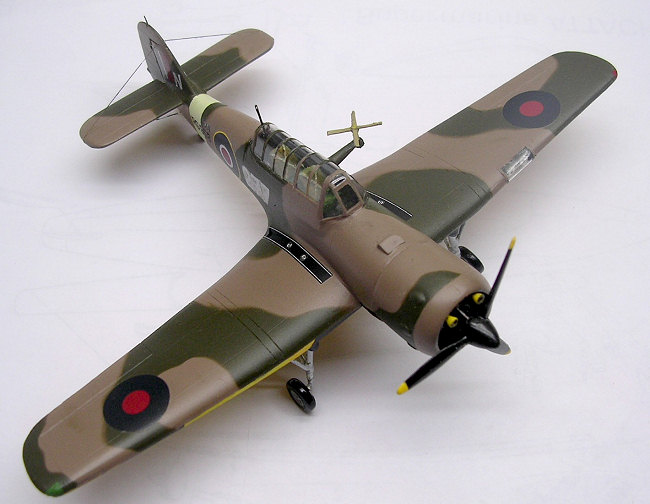
Pavla 1/72 Miles Martinet TT I
| KIT #: | ? |
| PRICE: | $ |
| DECALS: | Four options |
| REVIEWER: | Carmel. J. Attard |
| NOTES: | Short run kit with the usual bits |

| HISTORY |
The Martinet was the first aircraft that had been designed from the outset of Target Tug, to enter RAF service. Prior to this all target tugs had been obsolete type planes. The design was based on the Miles Master although the nose was longer to compensate for the extra weight of the towing gear in the rear cockpit which was either wind driven or by motorised winch. It carried six flag or sleeve type targets. Some aircraft were later used for air sea rescue duties.
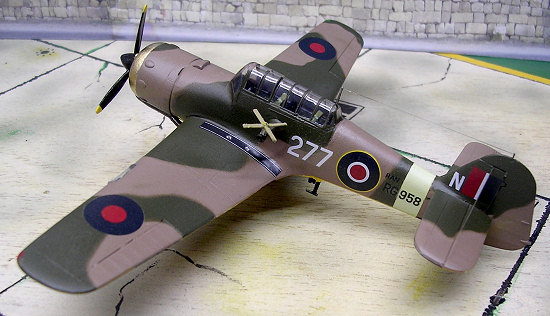 The driving unit of the Martinet was the
Bristol Mercury Type XX or Type XXX engine of 870 HP. The cockpit carried two
seats, for a pilot and a towing equipment operator. The prototype Martinet was
the TT Mk1 LR241 flown by Tommy Rose and passed its maiden flight at the end of
April 1942. The Martinet differed from the Master II by a new cockpit layout and
an air arm added to the port side which had the cable winch located in the rear
compartment, and by the targets container located in the rear compartment below
the fuselage between the main landing gear legs. The new Martinet TT1s served to
training of anti-aircraft artillery to training of fighter pilots and air
gunners of the RAF and Royal Navy bomber aircraft. For Air Sea rescue duties
they dropped dinghies over the sea while others towed gliders as well. Some
Martinets were modified to an unmanned radio controlled version that became
known as Queen Martinet. Martinets also flew in civilian markings in Sweden;
others were sold to air forces of France, Portugal, Belgium and the Navy of
Australia. Production of Martinet TT Is ended in 1945 after supplying 1724
aircraft with serials from EM410 to420, 434-481,496-532,545-593,613-662.
RG882-929, 948-997, RH113-121,122-148.162-192, HN861-HP528, RG882-RH365.
The driving unit of the Martinet was the
Bristol Mercury Type XX or Type XXX engine of 870 HP. The cockpit carried two
seats, for a pilot and a towing equipment operator. The prototype Martinet was
the TT Mk1 LR241 flown by Tommy Rose and passed its maiden flight at the end of
April 1942. The Martinet differed from the Master II by a new cockpit layout and
an air arm added to the port side which had the cable winch located in the rear
compartment, and by the targets container located in the rear compartment below
the fuselage between the main landing gear legs. The new Martinet TT1s served to
training of anti-aircraft artillery to training of fighter pilots and air
gunners of the RAF and Royal Navy bomber aircraft. For Air Sea rescue duties
they dropped dinghies over the sea while others towed gliders as well. Some
Martinets were modified to an unmanned radio controlled version that became
known as Queen Martinet. Martinets also flew in civilian markings in Sweden;
others were sold to air forces of France, Portugal, Belgium and the Navy of
Australia. Production of Martinet TT Is ended in 1945 after supplying 1724
aircraft with serials from EM410 to420, 434-481,496-532,545-593,613-662.
RG882-929, 948-997, RH113-121,122-148.162-192, HN861-HP528, RG882-RH365.
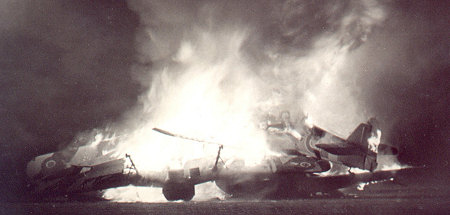 Through the early 40s up until early 50s
Martinets were very popular in Maltese skies. Several were permanently based at
Hal Far, Malta, to train Royal Navy gunners. Towards the end of the war years in
the Mediterranean some of these Martinets met a sad end because for one reason
or other such as being rendered surplus or beyond repair; these became obsolete
and were disposed of by fire. On the 5th of May 1946 No728 squadron
was formed as the Fleet Requirement Unit equipped with Martinets which continued
to give useful service alongside Mosquitos and other aircraft until the early
50s. Unlike the war years these surviving Martinets were not camouflaged but
were finished in aluminium upper and retained the yellow/black stripes to lower
fuselage and under wings. Of all the Martinets that were based at Hal Far, the
only item that remains until this
Through the early 40s up until early 50s
Martinets were very popular in Maltese skies. Several were permanently based at
Hal Far, Malta, to train Royal Navy gunners. Towards the end of the war years in
the Mediterranean some of these Martinets met a sad end because for one reason
or other such as being rendered surplus or beyond repair; these became obsolete
and were disposed of by fire. On the 5th of May 1946 No728 squadron
was formed as the Fleet Requirement Unit equipped with Martinets which continued
to give useful service alongside Mosquitos and other aircraft until the early
50s. Unlike the war years these surviving Martinets were not camouflaged but
were finished in aluminium upper and retained the yellow/black stripes to lower
fuselage and under wings. Of all the Martinets that were based at Hal Far, the
only item that remains until this
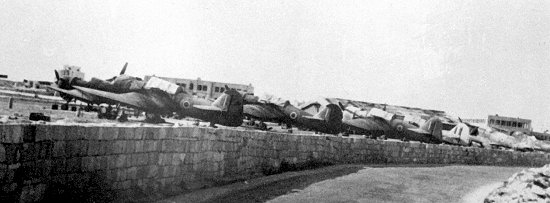 day was a complete Perspex cockpit canopy
which is on permanent display at the Malta Aviation Museum at Ta’Qali. Martinets
flew alongside Bolton Paul Defiant Target tug aircraft; the latter was based at Ta’Qali during the war. During the course of time Martinets
day was a complete Perspex cockpit canopy
which is on permanent display at the Malta Aviation Museum at Ta’Qali. Martinets
flew alongside Bolton Paul Defiant Target tug aircraft; the latter was based at Ta’Qali during the war. During the course of time Martinets
 disappeared from
Maltese skies and other target tug aircraft started to take their place such as
Mosquitoes, Sea Furies, Fireflies and Sturgeons. The last two types of target
tug aircraft that served in Malta for a good number if years were the Beaufighter and later the Meteor TT20s which remained in active service until
late in the 60s.
disappeared from
Maltese skies and other target tug aircraft started to take their place such as
Mosquitoes, Sea Furies, Fireflies and Sturgeons. The last two types of target
tug aircraft that served in Malta for a good number if years were the Beaufighter and later the Meteor TT20s which remained in active service until
late in the 60s.
| THE KIT |
Pavla models
seem to pick aircraft subjects that are appealing to WWII enthusiast modellers
in particular, and the Martinet has always been a model I always waned to build.
My desire to build a Martinet model goes back to several years when a kit
conversion appeared in some detail in an old issue of ‘Flying Review’ Vol.19
No5, 1963. This entailed creating a Martinet out of five
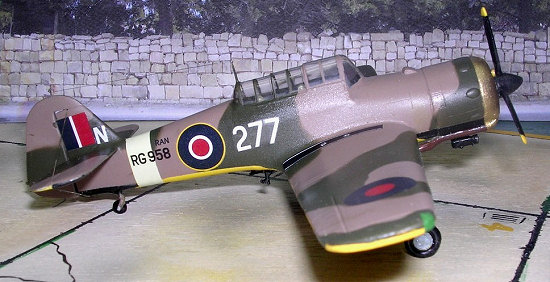 scale models that were
on the market at the time and also involved a certain degree of surgery. There
is no need to bother and follow the old way now as Pavla Models have released
the Miles M25 Martinet TT Mk1 to the popular scale of 1/72.
scale models that were
on the market at the time and also involved a certain degree of surgery. There
is no need to bother and follow the old way now as Pavla Models have released
the Miles M25 Martinet TT Mk1 to the popular scale of 1/72.
The kit is packed in one end opening box complete with a decal offer of 4 aircraft to choose from. The scale model is injection moulded in light grey plastic, contains light tan resin detail parts and two vac form clear canopies which are all enclosed in protective separate plastic bags. In common with other Pavla kits that I made comes a neat 12 page instruction booklet containing 18 stages of assembly of the kit. The resin detail parts are the radial engine, seat, column, cockpit side detail parts, wheels, struts and winch detail parts. There are three aircraft finishes; all equipped with the winch to unwind the drone while another, which is attached to the TT flight at St.Eval does not have this equipment installed. I found that it is best to make the choice of the aircraft that you want to model from the very start. My pick fell on a TT1 belonging to 723 FRU Squadron which formed on the Bankstown airfield, New South Wales, Australia. Interesting about my choice is that it still carried the markings of the original user No 1771 FAA Squadron. A side view in colour is depicted on the box cover and which I found quite inviting and helpful to arrive to my choice. Pavla merits praise at the way that large side views are displayed in the instruction sheet. This makes without doubt an excellent source of reference when it comes to paint any one of the four Martinets.
| CONSTRUCTION |
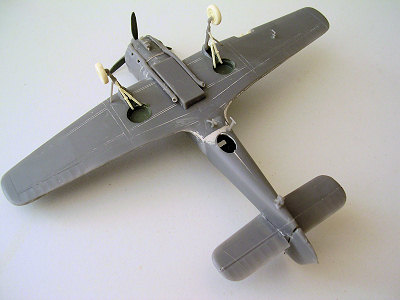 As I went along with assembling the kit I
made a few minor observations. The fit of the parts was generally good although
difficulty could arise when fitting of the wing assembly to the fuselage. Upon
building the model the instruction states that the three piece wing assembly
should be assembled first and then fitted to the fuselage. I have found however
that it is better to allow this step to a later stage i.e. after stage 14.This
would mean that the fuselage is first glued in one piece and then the lower wing
section is first brought to fit in place followed by the two upper wing halves.
In assembling the kit in this sequence will allow minor but vital adjustment to
the two upper halves. The wing to fuselage fit did need some filler to get a
smooth finish to the underside. The canopy and landing light clear cover comes
in vac form Perspex. The good thing about the canopy is that a great part of the
lower
As I went along with assembling the kit I
made a few minor observations. The fit of the parts was generally good although
difficulty could arise when fitting of the wing assembly to the fuselage. Upon
building the model the instruction states that the three piece wing assembly
should be assembled first and then fitted to the fuselage. I have found however
that it is better to allow this step to a later stage i.e. after stage 14.This
would mean that the fuselage is first glued in one piece and then the lower wing
section is first brought to fit in place followed by the two upper wing halves.
In assembling the kit in this sequence will allow minor but vital adjustment to
the two upper halves. The wing to fuselage fit did need some filler to get a
smooth finish to the underside. The canopy and landing light clear cover comes
in vac form Perspex. The good thing about the canopy is that a great part of the
lower 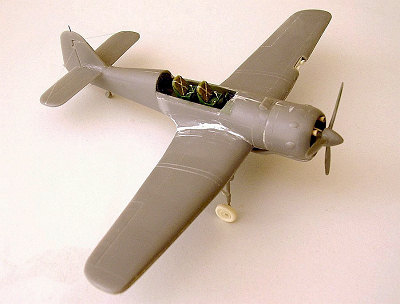 frame is to be painted and applying glue for a good fit will not spoil the
upper clear part. The canopy part is carefully cut using a pair of scissors, and
a dry fit is rehearsed until the desired fit is obtained. I painted cockpit
interior in cockpit green with touches of brown, white and black to seats and
instruments. Another observation is that the Royal Australian Navy Martinet
which is shown on the box cover appears to have undercarriage doors while on the
front page of the instructions the same aircraft does not have them. I have my
doubts if Martinets ever carried wheel doors. Other minor detailing added to the
kit involved drilling the exhaust pipes rear outlet. Cable guards were also
added around the fin and rudder in common with target tug aircraft. In fact this
is intended to prevent the tug cable from tangling with the moving elevators and
rudder. A wireless is also added which joins the antenna positioned on the
cockpit to the tail fin aerial.
frame is to be painted and applying glue for a good fit will not spoil the
upper clear part. The canopy part is carefully cut using a pair of scissors, and
a dry fit is rehearsed until the desired fit is obtained. I painted cockpit
interior in cockpit green with touches of brown, white and black to seats and
instruments. Another observation is that the Royal Australian Navy Martinet
which is shown on the box cover appears to have undercarriage doors while on the
front page of the instructions the same aircraft does not have them. I have my
doubts if Martinets ever carried wheel doors. Other minor detailing added to the
kit involved drilling the exhaust pipes rear outlet. Cable guards were also
added around the fin and rudder in common with target tug aircraft. In fact this
is intended to prevent the tug cable from tangling with the moving elevators and
rudder. A wireless is also added which joins the antenna positioned on the
cockpit to the tail fin aerial.
| COLORS & MARKINGS |
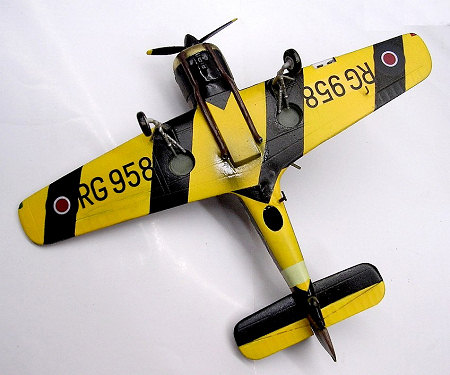 Painting the model required some sequence.
I have first given the underside an overall coat of semi gloss white. The black
and yellow stripes were added, starting with the underside being coated in
identification yellow. This was followed by masking the yellow and airbrushing
the semi matt black. After drying the lower surfaces were now masked and the
upper surface was coated in dark earth. To obtain an accurate camouflage pattern
as well as the required feathering where the colours meet, I then used
plasticine and Maskol in between. The dark green was then applied with an
airbrush. This may sound a tedious at some point or other but the end result was
quite effective and pleasing. The decals were of good quality with correct
register which adhered well over a coat of floor polish liquid. Finally the
Martinet was placed next to other target tug aircraft I have made which are the
Fairey Battle and the Sturgeon, the latter in Hal-Far based aircraft markings.
Painting the model required some sequence.
I have first given the underside an overall coat of semi gloss white. The black
and yellow stripes were added, starting with the underside being coated in
identification yellow. This was followed by masking the yellow and airbrushing
the semi matt black. After drying the lower surfaces were now masked and the
upper surface was coated in dark earth. To obtain an accurate camouflage pattern
as well as the required feathering where the colours meet, I then used
plasticine and Maskol in between. The dark green was then applied with an
airbrush. This may sound a tedious at some point or other but the end result was
quite effective and pleasing. The decals were of good quality with correct
register which adhered well over a coat of floor polish liquid. Finally the
Martinet was placed next to other target tug aircraft I have made which are the
Fairey Battle and the Sturgeon, the latter in Hal-Far based aircraft markings.
January 2007
Copyright ModelingMadness.com. All rights reserved. No reproduction in part or in whole without express permission from the editor.
If you would like your product reviewed fairly and fairly quickly, please contact the editor or see other details in the Note to Contributors.